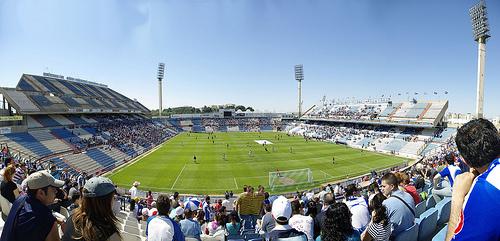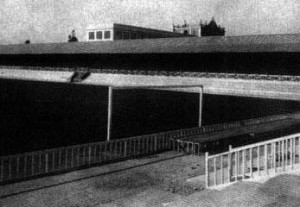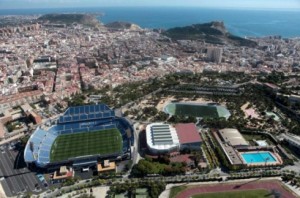Estadio José Rico Pérez – Alicante’s footballing cathedral
-
Updated: 5 October, 2011

By Chris Clements (estadiosdefutbolenespanana)
The Estadio José Rico Pérez is a monument to the visionary President of Hercules CF, who saw in the 1960’s that Alicante was at the centre of the Costa Brava’s economic boom and wanted his beloved club to be a part of it. But first of all, a little background information.
Way back in 1914 a youth team was formed and its members struck upon an inspirational name, that of ancient Greek hero Hercules. Whilst relatively useful as a youth team, the senior team only started to prosper when an older and more successful local rival hit the rocks. Club Natacion de Alicante was the footballing arm of the local swimming club and in the 1920’s was the dominant local club. However, after losing the plot in a match at Valencia CF in February 1927, the Valencian Football Federation threw the book at them and rather than take the fine, the footballing arm of the swimming club was wound up.
Natacion played their matches at Campo de la Vina, which they shared with Hercules, so rather than form a new club, the players and officials of Natacion joined Hercules, who in turn adopted their neighbours blue and white striped shirts. Campo de la Vina was a basic and by the time the club appeared in the Tercrea for the 1928-29 season, thoughts were already turning to a new stadium. In 1932 the club headed just 500 metres east to the purpose built Campo de Bardin.
 It was quite an impressive ground by 1930’s standards with a fulllength stand on one side of the pitch and decent terracing around the other three sides. Over the next 20 years, Hercules saw three short visits to La Primera, but conversely, also tasted a spell in the Tercera. As their crowds grew, the club decided to leave the Campo de Badin and in 1954 returned to a renovated and expanded Campo de la Vina. Whilst it did not have a covered stand it did have a higher capacity.
It was quite an impressive ground by 1930’s standards with a fulllength stand on one side of the pitch and decent terracing around the other three sides. Over the next 20 years, Hercules saw three short visits to La Primera, but conversely, also tasted a spell in the Tercera. As their crowds grew, the club decided to leave the Campo de Badin and in 1954 returned to a renovated and expanded Campo de la Vina. Whilst it did not have a covered stand it did have a higher capacity.
At the end of the sixties, José Rico Pérez began his presidency, and so would begin the most successful period in the clubs history. Perez made his fortune as a builder and was instrumental in the club’s return to La Primera in 1974-75 season, the refinancing of Campo de la Vina, and ultimately the building of the stadium that carries his name.
The new stadium took 11 months to build and had an initial capacity of 30,000. It had on its southern side a two tiered stand, with large banks of terracing around the remaining three sides. The whole project cost 28 million pesetas and on 3 August 1974, Hercules played host to FC Barcelona in a friendly to mark the opening of the stadium, which Barca with Cruyff, Neeskens et el won 4-0.Inspired by their new home, Hercules achieved their highest ever finish in La Primera with fifth place in 1974-75.
In 1977, the ever resourceful José Rico Pérez persuaded to Spanish World Cup Committee that Alicante would be an ideal host city for the 1982 finals. The stadium would require further development and Señor Pérez dipped into his considerably deep pockets and financed the building of a huge extension to the north terrace, that would become known as the Grada del Tejero. With a capacity of 38,700, Alicante hosted two group matches featuring Argentina, El Salvador and Hungary, as well as the Third Place match between Poland and France. The Spanish National side has used the stadium on six occasions, drawing the first match against Hungary in March 1977 and winning on every visit since. They return for the first time in 10 years when La Seleccion play Scotland on 11 October 2011.
The completion of the redevelopment in the spring of 1982 coincided with the relegation of Hercules to La Segunda. Two seasons later they were back in La Primera, but José Rico Pérez was no longer president, having to stand down due to ill health. Without his guidance and money, Hercules fell on hard times and by 1988 they were playing in Segunda 2b. Five seasons at this level saw the debts grow and when they returned to La Segunda in 1994, the club was 575 million pesatas in the red. The only option was to sell the stadium to the municipality.
In 2001, city rival Alicante CF was promoted to Segunda 2b and with their own Villafranqueza ground not suitable for use, they moved into Estadio José Rico Pérez. They even customised it on match days by replacing Hercules CF crests and strategically placing sacks over the white seats that spelt “Hercules CF” in order to spell “Alicante CF”. In 2007, the directors of the Hercules CF bought back the stadium from the Municipality and so began the next phase of the clubs history.
Back in La Primera for the 2010-11 season and with Alicante CF back at a redeveloped Villafranqueza, the Estadio José Rico Pérez was converted into a 30,000 all-seat stadium as part of a 45 million euro facelift of the stadium and surrounding sports city. Work on the stadium included the installation of new seats, press facilities and a new pitch. Hercules has achieved a great deal in the past five years, however, with mounting debts and relegation back to La Segunda after just one season, their long-term survival is their next and most important herculean task.
To read more on the footballing stadiums of Spain, visit Chris’s excellent site Estadios de fútbol en España



You must be logged in to post a comment Login